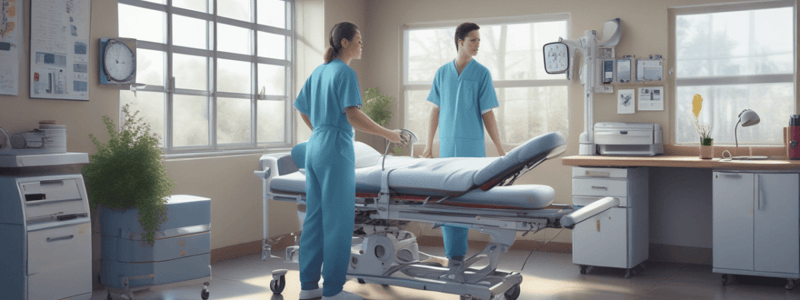Podcast
Questions and Answers
What is the correct body mechanics technique when pulling a patient?
What is the correct body mechanics technique when pulling a patient?
- Extending arms without bending knees
- Reaching backward and bending at the waist
- Using back strength instead of arm strength
- Grasping the patient with elbows close to the body (correct)
When should one call for additional help when lifting a patient?
When should one call for additional help when lifting a patient?
- After attempting the lift once
- Only if someone else suggests it
- When unsure of personal limits (correct)
- When they are very confident in their abilities
What is essential when performing a two-person body drag?
What is essential when performing a two-person body drag?
- Using elbows for grasping the patient
- Ensuring coordination and steady effort (correct)
- Avoiding coordination and steady effort
- Competing against the other person for control
Why is proper positioning of team members vital when carrying patients up and down stairs?
Why is proper positioning of team members vital when carrying patients up and down stairs?
What type of moves are used in life-threatening situations?
What type of moves are used in life-threatening situations?
Why are special considerations needed for geriatric patients during movements?
Why are special considerations needed for geriatric patients during movements?
Flashcards are hidden until you start studying
Study Notes
- Body mechanics and principles are crucial when moving, lifting, and carrying patients to ensure safety and minimize strain on the back.
- When pulling a patient, it is important to reach forward, grasp the patient with elbows just beyond the torso, bend knees, and extend arms while keeping back locked.
- Reposition feet for balanced force, use arm strength (not back), and repeat steps as needed while maintaining communication with partners.
- When performing a two-person body drag, coordination and steady effort are essential to avoid accidents and ensure a smooth movement.
- Knowing and communicating personal limits is crucial before attempting to lift a patient; if unsure, call for additional help and plan accordingly.
- Proper positioning of the strongest team members at the head and foot ends is vital when carrying patients up and down stairs to prevent accidents or injuries.
- Emergency moves are used in life-threatening situations, urgent moves involve rapid extrication, and non-urgent moves are for stable patients in a safe environment.
- Different carry techniques are demonstrated for emergency situations, emphasizing the need for creativity, care, and communication with the patient.
- Special considerations are needed for geriatric patients due to skeletal changes, skin fragility, and the importance of being compassionate, slow, and anticipatory in movements.
- Bariatrics, dealing with obesity management, poses challenges for healthcare workers in terms of back injuries due to the high prevalence of obesity in the US population.
Studying That Suits You
Use AI to generate personalized quizzes and flashcards to suit your learning preferences.



